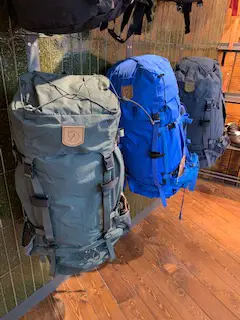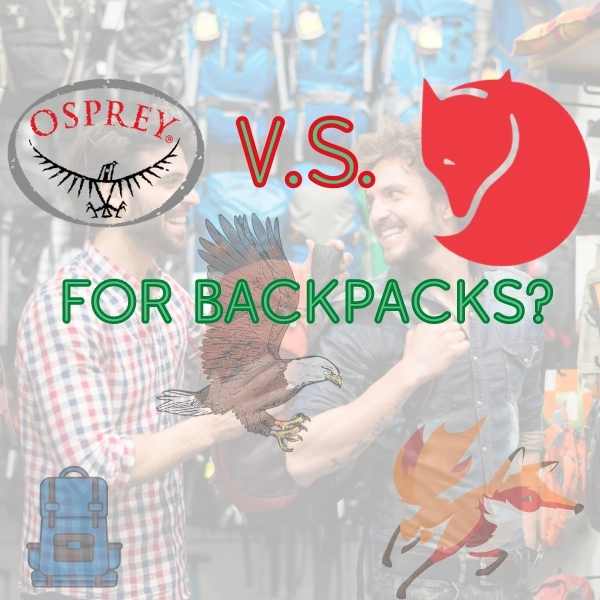If you’re someone who particularly loves outdoor adventures such as hiking, camping, or climbing, then you might already be familiar with some daypacks from Fjällräven or Osprey.
Both brands are very reputable when it comes to backpacks, so why choose one over the other?
Whereas Osprey is a well-known and popular brand with a great reputation in North America, Fjällräven is a lesser-known Scandinavian brand that values minimalism, usability, and durability over advanced technical details and lightweight materials for their backpacks.
The word “Fjällräven” is known as the Arctic Fox in the country of Sweden. One of their first and classic releases was the iconic Kanken backpack with a simple design and durable materials released in 1968.
Now, Fjällräven’s products have become more popular also outside their home in Scandinavia, and are gaining interest in the US and worldwide. Some of their most bought products are jackets, trousers, and their most sold item is the very popular Kanken backpack.
However, if you’re keener on covering long distances over an extended period, a mere commuter rucksack such as the Osprey Talon or Fjällräven Kaken discussed below, will prove to be insufficient. And I will get into their relevant selection of larger (> 60L) hiking backpacks as well.
With the recognizable sea hawk as their logo, Osprey is another reputable brand that, like Fjällräven, get their inspiration from hikers and outdoor lovers, and is also getting increasingly known for its eco-friendly backpacks made for adventurers.
Osprey is known for its lightweight, yet, functional and technical backpacks. Some people like the numerous adjustment possibilities; others are easily annoyed by the hundreds of straps and pockets of most Osprey backpacks.

It can be quite hard to choose between the two brands, especially if you have not encountered Fjällräven before, but I will do my best to help you decide between the two brands below.
Between Fjällräven and Osprey, there are indeed important differences in functionality, service, and materials that I will get into.
So let’s jump into different Osprey and Fjällräven backpacks to help you decide which one best fits your needs.
Are Fjällräven or Osprey backpacks better?
Among the top backpacking brands on my list of companies that offer quality camping and hiking, backpacks are Fjällräven and Osprey.
I own a range of backpacks myself, and among them are three Osprey and two Fjällräven packs, so I will take my starting point in personal experience.
Whereas Fjällräven is mainly known for its extremely durable and (almost) waterproof G 1000 fabric, versatile enough for intrepid travelers to use in extreme weather conditions, Osprey is famous for its very well featured and technical lightweight rucksacks.
Backpacks have evolved from the usually large, bulky external frames that you’d have to carry while traversing through the forest with a sore body, to, nowadays, being much more technical and ergonomic designs that your back will thank you for.
I have written an article on how to waterproof your Fjällräven backpack if you’re interested.
Fjällräven Kajka vs Osprey Aether
The Fjällräven Kajka and Osprey Aether are among the most appreciated hiking backpacks globally because of how user-friendly and unique both bags are.
Both backpacks are similar in features like several compression straps, adjustable shoulder straps, rain covers, emergency whistles, mesh pockets, and detachable top lids, which can be used as separate bags.
In my opinion, Fjällräven Kajka is clearly the superior choice here. The build quality is just superior and I have used mine for years now without any obvious wear and tear showing.
If you have the budget and don’t mind the extra grams of weight, the Kajka will reward you with a much more comfortable carrying system and a build that will last you a lifetime!
Osprey on the other hand is really known for its ingenious designs and high functionality. However, the thousand pockets and straps will annoy some people.
Another benefit of the Osprey backpacks though, is that while they may be less durable, Osprey offers lifetime warranties for most of their products – making it less risky to go for the lighter option!
These two packs are fairly large at +55 Liters, and if you do not need all that space and intend on shorter hikes or day trips, the Osprey Exos or Fjällräven Bergtagen (which is completely waterproof!) are likely to be better options.
Fjällräven Kajka
The Fjällräven Kajka hiking rucksack is a heavy-duty, functional, and durable backpack suitable for carrying heavy loads across long distances while still being comfortable and able to last.
The Fjällräven Kajka 65L backpack is perhaps Fjällräven’s most popular backpack and it is made from their durable and waterproof Vinylon F fabric material – a 600D polyester material suitable for light rain and any dirt and damp activities. During heavy rain, however, the built-in rain cover should be used.

Not only does it have sufficient cargo space and pockets for your gear, but it also makes for an excellent backpack for those who like to frequent traveling or backpacking without minding the additional weight.
Pros
- Well-made and extremely durable
- Great support for heavy loads
- Versatile pockets
- Extra storage space
- Leather details and Birch wooden frame
- Pretty much waterproof 600D polyester material
Cons
- Somewhat pricy – check the latest price on Amazon
- Heavy
- Stiffer form
I have used the Kajka backpack for a couple of years now, and I am really pleased with it. It is easy and intuitive to use, while still having the essential features needed.
One of the reasons I love the Kajka backpack is that it has two zippers going all along the length of the backpack allowing me to open the main as in a suitcase. So no need to stick your arm in from the top to fiddle around in the dark with no overview of your stuff!
Osprey Aether/Xenith
The Osprey Aether is another popular model for when you’re going on extended trips while carrying massive loads across remote corners of the globe. It is very similar to their older Xenith model that it replaced from 2021 onwards.
It comes in sizes from 45L to 85L and has a variety of colors.
The Ospreys AirScape™ suspension system is indeed more technical and ergonomic, which combined with the lighter fabrics (nylon and polyester) used, will likely be more pleasant for most people to carry.
Furthermore, the BioForm™ of the hip belt and shoulder straps makes the pack very comfortable to wear for hours on end.
Pros
- Excellent pocket design
- Top-notch carrying system and foam on the waist belt and shoulder straps
- Many straps and a mesh to carry additional gear
Cons
- Less durable
- Annoyingly many straps
- Less water resistant
- No integrated rain cover
Compared to Fjallraven Kajka, the Osprey Osprey Aether is lighter with more adjustability but does not allow for the same maximal weight (maximum 27kg recommended) to be carried.

The Osprey Exos is another very popular option with similar features but for shorter trips and with a very light frame. I’ve even used the 38-liter version for a 10-day hike without running out of space!
Fjällräven Kanken vs Osprey Daylite
So what about the smaller backpacks from Fjällräven and Osprey? If you need a medium-sized pack for commuting with a laptop, some food, changing clothes, and a book or two?
The most classical and well know Fjällräven backpacks of them all is the Kanken (actually spelled Kånken – meaning “to carry in Swedish) backpack, with its classical time-tested design.
The Fjällräven Kanken No. 2 is the classic Kanken with a pleasing twist. With the same design yet an updated size and made of the more durable G 1000. Its practical features make it highly convenient to store all your gear. It’s also dirt and water-resistant just like the original Kanen which is made of the high-quality Vinylon F.
Fjallraven, Kanken No. 2 is an updated version of the Kanken Classic made with their more durable (and waterpoofable) G-1000 fabric.
If you want to know more about the different materials that these backpacks are made of, take a look at my post on Fjälrävens fabrics and the one on nylon and polyester materials often used for tents and backpacks.
Reasons to choose Kanken
- Stylish and fashionable
- Comes in practically all colors…
- Easy to clean
- Very water resistant
- Authentic
- Durable
Downsides of Kanken
- Not ideal for heavy loads with no/little padding
- Pricier than other bags
- Limited adjustments and functionality
Osprey Daylite
When it comes to compatibility, comfort, and additional carry and storage options, the Daylite is a great daypack to have around town. The Daylite Plus version of the bag is slightly larger which makes it more suitable for extended adventures because of its ample padding, convenience, and suspension features.
The Daylite bag comes in at just around 1 pound which really does live up to the “lite” in its name, however, the volume is also at the lower end at 13L, whereas the plus version is 20L and the Hikelite upgrade is 26L
Why we like Osprey Daylite
- User-friendly pockets
- Excellent access
- Light weight (1.05 lbs)
- Ventilated back
Why we would prefer Fjällräven Kanken
- The Daylite is made from Low durability
- Daylite is less water resistant than Kanken
The volume of 13 L makes the Daylite somewhat small for some purposes. And whereas the Kanken boasts a 16L capacity, Osprey also makes a pack with twice the volume (26L) of the Daylite – the Hikelite backpack that is a bit more padded and has a large outer pocket, and, as the name implies, is intended more for hikers rather than commuters.
Fjällräven Kanken vs. Osprey Talon
The Osprey Talon is in many ways what Kanken is to Fjällräven – a classic pack with lots of colors and sizes to select from. It is the predecessor of the updated Daylite pack, but it still has its merits!
Kanken is great as an everyday backpack due to its ideal size, including the practical features that maximize durability and storage space and so is the Osprey Talon – so which is best for you?
For hardcore trekkers or cyclists commuting long distances who require more comfort than the minimally padded Kanken can provide, the Osprey Talon is a great option!
The Talon comes with more adjustment options and more pockets, which may be nice to have, but annoying if you value simplistic solutions. It also features a soft hip-belt that really assists in treating stability when cycling.
How does Osprey Talon compare to Fjällrävens Kanken?
The Osprey Talon is a versatile and functional rucksack that works well for minimalist or weekend multi-day trips due to the extra space, comfortable shape, and easy loading access.
This pack makes for a do-it-all option that will work for everyday commuter use due to the ventilated back, but also for hiking if you chose the larger sizes.
Great things about Talon
- Different sizes available for optimal storage space
- Durable for everyday use
- Sweat diverting
Not so good things to say about Talon
- The mesh is easily damaged and gets dirty fast.
- Reduced functionality due to a top-loading-only pack
- Materials are not quite on par with Fjällrävens.
Are Fjällräven backpacks worth it?
With the fast-paced innovative backpacks produced by brands like Osprey, why would you pay extra for a Fjällräven backpack?
Owning several backpacks from Fjällräven myself, I have always felt that other brands would be a compromise on quality. However, needing that extra quality in a sleek minimalistic design is not what everyone needs for the following reasons:
- Fjällrävens materials, while durable, are not as light as some people would like.
- The backpacks from Fjällräven are mostly for rough conditions and optimized for winter.
- Their products, although cheeper in the US than in Sweden, are considered somewhat expensive.
There are definitely times when these are fine reasons not to buy a backpack.
However, being fairly unique in their design and approach to outdoor gear, I think you will not be disappointed with your backpack from Fjällräven if you choose to purchase one, and it will most likely last you the rest of your life!
If none of these backpacks appeal to you, or you’re just curious about how other outdoor brands compare to Fjällräven, check out my post on how The North Face compares to Fjallraven here.















